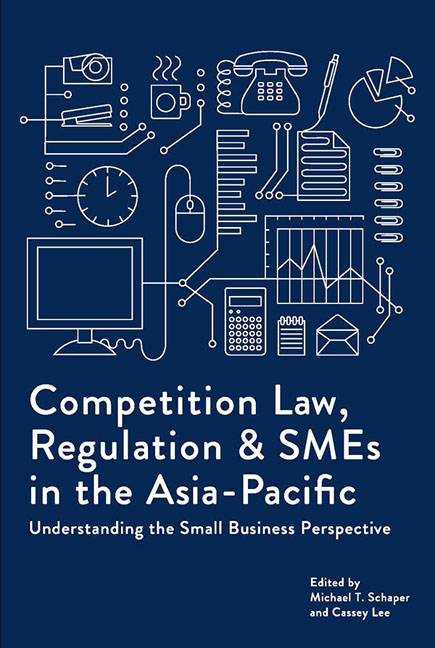 Competition Law, Regulation and SMEs in the Asia-Pacific
Competition Law, Regulation and SMEs in the Asia-Pacific Foreword
Published online by Cambridge University Press: 05 August 2017
Summary
In many Asia-Pacific economies, competition law and regulation has been in operation for decades, setting the rules of the game for business. Typically the law covers the behaviours of dominant firms (i.e. vertical arrangements) and anti-competitive practices in markets (i.e. horizontal arrangements). But while such regulation is designed as a general framework for firm behaviour, those frameworks have not always kept pace with modern developments.
Competition law was traditionally seen as something to guide the behaviour of large or dominant firms. But the role of Asia-Pacific Economic Cooperation (APEC) small and medium-sized enterprises (SMEs) is changing as they become more connected to the international economy. Electronic commerce and global supply chains are encouraging them to become more globalized. New technologies are acting as disruptive forces to existing markets, and international supply chains are altering the traditional nature of vertical arrangements.
These changing realities have implications for modern competition law and regulation. Regulatory authorities need to understand the new roles of SMEs, and communicate their legal obligations.
Policymakers need to design systems that encourage harmonized or similar commercial standards across borders, and there needs to be common views about how to enforce behaviours across borders with appropriate cross-border judicial resolutions. Public and private dispute resolution systems need to be accessible to SMEs.
My own experience in competition law in the 1990s was that competition laws were not particularly well designed for SMEs, and that SMEs were not particularly well informed about them. It is very pleasing to see so much progress since then, as this book spells out.
Congratulations to the ISEAS – Yusof Ishak Institute and the authors for drawing our attention to these issues. This book and the seminar that it is based on are important steps in remedying the gaps in knowledge and policy in the Asia-Pacific.
- Type
- Chapter
- Information
- Competition Law, Regulation and SMEs in the Asia-PacificUnderstanding the Small Business Perspective, pp. ix - xPublisher: ISEAS–Yusof Ishak InstitutePrint publication year: 2016


